The Performance and Reaction Mechanism of Untreated Steel Slag Used as a Microexpanding Agent in Fly Ash-Based Geopolymers
Abstract
1. Introduction
2. Experimental Program
2.1. Materials
2.1.1. Geopolymer Binder
2.1.2. Mixture Preparation
2.2. Testing Procedures
2.2.1. Mechanical Properties
2.2.2. Microstructural Characterization
3. Results and Discussion
3.1. Compressive Strength and Bulk Density
3.2. XRD Analysis
3.3. FTIR Analysis
3.4. MIP Analysis
3.5. SEM-EDS Analysis
3.6. Thermogravimetric Analysis
3.7. Expansion Mechanism
4. Conclusions
- (1)
- The untreated SSL was successfully utilized in fly ash–steel slag geopolymer, and the final geopolymer products were a type of composite containing C-A-S-H, N-A-S-H, and unreacted crystalline phases as fillers.
- (2)
- The low dosage of SSL reduces the compressive strength in the geopolymer reaction, which is due to its lower reactivity than FA. On the contrary, the high dosage of SSL makes the samples micro-expanded, with a decrease in the dry density and refinement of the pore size.
- (3)
- The expansion of samples was caused by chemical and physical changes in free lime and crystal growth in porous media.
Author Contributions
Funding
Data Availability Statement
Acknowledgments
Conflicts of Interest
References
- Mostafaei, H.; Bahmani, H.; Mostofinejad, D.; Wu, C. A Novel Development of HPC without Cement: Mechanical Properties and Sustainability Evaluation. J. Build. Eng. 2023, 76, 107262. [Google Scholar] [CrossRef]
- Bahmani, H.; Mostafaei, H.; Ghiassi, B.; Mostofinejad, D.; Wu, C. A Comparative Study of Calcium Hydroxide, Calcium Oxide, Calcined Dolomite, and Metasilicate as Activators for Slag-Based HPC. Structures 2023, 58, 105653. [Google Scholar] [CrossRef]
- Shao, Z.; Wang, J.; Jiang, Y.; Zang, J.; Wu, T.; Ma, F.; Qian, B.; Wang, L.; Hu, Y.; Ma, B. The Performance of Micropore-Foamed Geopolymers Produced from Industrial Wastes. Constr. Build. Mater. 2021, 304, 124636. [Google Scholar] [CrossRef]
- Gao, X.; Yu, Q.L.; Brouwers, H.J.H. Properties of Alkali Activated Slag-Fly Ash Blends with Limestone Addition. Cem. Concr. Compos. 2015, 59, 119–128. [Google Scholar] [CrossRef]
- Rashad, A.M.; Mosleh, Y.A.; Mokhtar, M.M. Thermal Insulation and Durability of Alkali-Activated Lightweight Slag Mortar Modified with Silica Fume and Fly Ash. Constr. Build. Mater. 2024, 411, 134255. [Google Scholar] [CrossRef]
- Huang, D.; Liu, Z.; Lin, C.; Lu, Y.; Li, S. Effects and Mechanisms of Component Ratio and Cross-Scale Fibers on Drying Shrinkage of Geopolymer Mortar. Constr. Build. Mater. 2024, 411, 134299. [Google Scholar] [CrossRef]
- Yang, X.; Wu, S.; Xu, S.; Chen, B.; Chen, D.; Wang, F.; Jiang, J.; Fan, L.; Tu, L. Effects of GBFS Content and Curing Methods on the Working Performance and Microstructure of Ternary Geopolymers Based on High-Content Steel Slag. Constr. Build. Mater. 2024, 410, 134128. [Google Scholar] [CrossRef]
- Güllü, H.; Cevik, A.; Al-Ezzi, K.M.A.; Gülsan, M.E. On the Rheology of Using Geopolymer for Grouting: A Comparative Study with Cement-Based Grout Included Fly Ash and Cold Bonded Fly Ash. Constr. Build. Mater. 2019, 196, 594–610. [Google Scholar] [CrossRef]
- Assaedi, H.; Alomayri, T.; Kaze, C.R.; Jindal, B.B.; Subaer, S.; Shaikh, F.; Alraddadi, S. Characterization and Properties of Geopolymer Nanocomposites with Different Contents of Nano-CaCO3. Constr. Build. Mater. 2020, 252, 119137. [Google Scholar] [CrossRef]
- Zhang, Y.; Liu, H.; Ma, T.; Gu, G.; Chen, C.; Hu, J. Understanding the Changes in Engineering Behaviors and Microstructure of FA-GBFS Based Geopolymer Paste with Addition of Silica Fume. J. Build. Eng. 2023, 70, 106450. [Google Scholar] [CrossRef]
- Liu, M.; Hu, R.; Zhang, Y.; Wang, C.; Ma, Z. Effect of Ground Concrete Waste as Green Binder on the Micro-Macro Properties of Eco-Friendly Metakaolin-Based Geopolymer Mortar. J. Build. Eng. 2023, 68, 106191. [Google Scholar] [CrossRef]
- Feng, B.; Liu, J.; Chen, Y.; Tan, X.; Zhang, M.; Sun, Z. Properties and Microstructure of Self-Waterproof Metakaolin Geopolymer with Silane Coupling Agents. Constr. Build. Mater. 2022, 342, 128045. [Google Scholar] [CrossRef]
- Mesgari, S.; Akbarnezhad, A.; Xiao, J.Z. Recycled Geopolymer Aggregates as Coarse Aggregates for Portland Cement Concrete and Geopolymer Concrete: Effects on Mechanical Properties. Constr. Build. Mater. 2020, 236, 117571. [Google Scholar] [CrossRef]
- Ma, F.; Zhou, L.; Luo, Y.; Wang, J.; Ma, B.; Qian, B.; Zang, J.; Hu, Y.; Ren, X. The Mechanism of Pristine Steel Slag for Boosted Performance of Fly Ash-Based Geopolymers. J. Indian Chem. Soc. 2022, 99, 100602. [Google Scholar] [CrossRef]
- Han, L.; Wang, J.; Liu, Z.; Zhang, Y.; Jin, Y.; Li, J.; Wang, D. Synthesis of Fly Ash-Based Self-Supported Zeolites Foam Geopolymer via Saturated Steam Treatment. J. Hazard. Mater. 2020, 393, 122468. [Google Scholar] [CrossRef] [PubMed]
- He, J.; Zhang, J.; Yu, Y.; Zhang, G. The Strength and Microstructure of Two Geopolymers Derived from Metakaolin and Red Mud-Fly Ash Admixture: A Comparative Study. Constr. Build. Mater. 2012, 30, 80–91. [Google Scholar] [CrossRef]
- Yazdi, M.A.; Liebscher, M.; Hempel, S.; Yang, J.; Mechtcherine, V. Correlation of Microstructural and Mechanical Properties of Geopolymers Produced from Fly Ash and Slag at Room Temperature. Constr. Build. Mater. 2018, 191, 330–341. [Google Scholar] [CrossRef]
- Lynch, J.L.V.; Baykara, H.; Cornejo, M.; Soriano, G.; Ulloa, N.A. Preparation, Characterization, and Determination of Mechanical and Thermal Stability of Natural Zeolite-Based Foamed Geopolymers. Constr. Build. Mater. 2018, 172, 448–456. [Google Scholar] [CrossRef]
- Gómez-Casero, M.A.; Pérez-Villarejo, L.; Castro, E.; Eliche-Quesada, D. Effect of Steel Slag and Curing Temperature on the Improvement in Technological Properties of Biomass Bottom Ash Based Alkali-Activated Materials. Constr. Build. Mater. 2021, 302, 124205. [Google Scholar] [CrossRef]
- Bai, T.; Song, Z.G.; Wu, Y.G.; Hu, X.D.; Bai, H. Influence of Steel Slag on the Mechanical Properties and Curing Time of Metakaolin Geopolymer. Ceram. Int. 2018, 44, 15706–15713. [Google Scholar] [CrossRef]
- Khan, M.S.H.; Castel, A.; Akbarnezhad, A.; Foster, S.J.; Smith, M. Utilisation of Steel Furnace Slag Coarse Aggregate in a Low Calcium Fly Ash Geopolymer Concrete. Cem. Concr. Res. 2016, 89, 220–229. [Google Scholar] [CrossRef]
- Liu, J.; Hu, L.; Tang, L.; Zhang, E.Q.; Ren, J. Shrinkage Behaviour, Early Hydration and Hardened Properties of Sodium Silicate Activated Slag Incorporated with Gypsum and Cement. Constr. Build. Mater. 2020, 248, 118687. [Google Scholar] [CrossRef]
- Jin, F.; Gu, K.; Al-Tabbaa, A. Strength and Drying Shrinkage of Reactive MgO Modified Alkali-Activated Slag Paste. Constr. Build. Mater. 2014, 51, 395–404. [Google Scholar] [CrossRef]
- Melo Neto, A.A.; Cincotto, M.A.; Repette, W. Drying and Autogenous Shrinkage of Pastes and Mortars with Activated Slag Cement. Cem. Concr. Res. 2008, 38, 565–574. [Google Scholar] [CrossRef]
- Li, Z.; Nedeljković, M.; Chen, B.; Ye, G. Mitigating the Autogenous Shrinkage of Alkali-Activated Slag by Metakaolin. Cem. Concr. Res. 2019, 122, 30–41. [Google Scholar] [CrossRef]
- Sun, K.; Peng, X.; Chu, S.H.; Wang, S.; Zeng, L.; Ji, G. Utilization of BOF Steel Slag Aggregate in Metakaolin-Based Geopolymer. Constr. Build. Mater. 2021, 300, 124024. [Google Scholar] [CrossRef]
- Shen, W.; Zhou, M.; Ma, W.; Hu, J.; Cai, Z. Investigation on the Application of Steel Slag-Fly Ash-Phosphogypsum Solidified Material as Road Base Material. J. Hazard. Mater. 2009, 164, 99–104. [Google Scholar] [CrossRef] [PubMed]
- Guo, X.; Pan, X. Mechanical Properties and Mechanisms of Fiber Reinforced Fly Ash–Steel Slag Based Geopolymer Mortar. Constr. Build. Mater. 2018, 179, 633–641. [Google Scholar] [CrossRef]
- Zhang, J.; Li, S.; Li, Z. Investigation the Synergistic Effects in Quaternary Binder Containing Red Mud, Blast Furnace Slag, Steel Slag and Flue Gas Desulfurization Gypsum Based on Artificial Neural Networks. J. Clean. Prod. 2020, 273, 122972. [Google Scholar] [CrossRef]
- Zhao, Y.; Shi, T.; Cao, L.; Kan, L.; Wu, M. Influence of Steel Slag on the Properties of Alkali-Activated Fly Ash and Blast-Furnace Slag Based Fiber Reinforced Composites. Cem. Concr. Compos. 2021, 116, 103875. [Google Scholar] [CrossRef]
- He, J.; Jie, Y.; Zhang, J.; Yu, Y.; Zhang, G. Synthesis and Characterization of Red Mud and Rice Husk Ash-Based Geopolymer Composites. Cem. Concr. Compos. 2013, 37, 108–118. [Google Scholar] [CrossRef]
- Wang, M.; Qian, B.; Jiang, J.; Liu, H.; Cai, Q.; Ma, B.; Hu, Y.; Wang, L. The Reaction between Ca2+ from Steel Slag and Granulated Blast-Furnace Slag System: A Unique Perspective. Chem. Pap. 2020, 74, 4401–4410. [Google Scholar] [CrossRef]
- Temuujin, J.; van Riessen, A.; Williams, R. Influence of Calcium Compounds on the Mechanical Properties of Fly Ash Geopolymer Pastes. J. Hazard. Mater. 2009, 167, 82–88. [Google Scholar] [CrossRef] [PubMed]
- Zhao, X.; Liu, C.; Zuo, L.; Wang, L.; Zhu, Q.; Wang, M. Investigation into the Effect of Calcium on the Existence Form of Geopolymerized Gel Product of Fly Ash Based Geopolymers. Cem. Concr. Compos. 2019, 103, 279–292. [Google Scholar] [CrossRef]
- Alventosa, K.M.L.; White, C.E. The Effects of Calcium Hydroxide and Activator Chemistry on Alkali-Activated Metakaolin Pastes. Cem. Concr. Res. 2021, 145, 106453. [Google Scholar] [CrossRef]
- GB/T 11969-2008; Standard for Test Methods of Autoclaved Aerated Concrete. Standardization Administration of the People’s Republic of China: Beijing, China, 2008.
- Zhang, Z.; Provis, J.L.; Reid, A.; Wang, H. Geopolymer Foam Concrete: An Emerging Material for Sustainable Construction. Constr. Build. Mater. 2014, 56, 113–127. [Google Scholar] [CrossRef]
- Song, W.; Zhu, Z.; Pu, S.; Wan, Y.; Huo, W.; Song, S.; Zhang, J.; Yao, K.; Hu, L. Efficient Use of Steel Slag in Alkali-Activated Fly Ash-Steel Slag-Ground Granulated Blast Furnace Slag Ternary Blends. Constr. Build. Mater. 2020, 259, 119814. [Google Scholar] [CrossRef]
- Song, W.; Zhu, Z.; Peng, Y.; Wan, Y.; Xu, X.; Pu, S.; Song, S.; Wei, Y. Effect of Steel Slag on Fresh, Hardened and Microstructural Properties of High-Calcium Fly Ash Based Geopolymers at Standard Curing Condition. Constr. Build. Mater. 2019, 229, 116933. [Google Scholar] [CrossRef]
- Ma, S.; Ge, D.; Li, W.; Hu, Y.; Xu, Z.; Shen, X. Reaction of Portland Cement Clinker with Gaseous SO2 to Form Alite-Ye’elimite Clinker. Cem. Concr. Res. 2019, 116, 299–308. [Google Scholar] [CrossRef]
- Ye, N.; Chen, Y.; Yang, J.; Liang, S.; Hu, Y.; Xiao, B.; Huang, Q.; Shi, Y.; Hu, J.; Wu, X. Co-Disposal of MSWI Fly Ash and Bayer Red Mud Using an One-Part Geopolymeric System. J. Hazard. Mater. 2016, 318, 70–78. [Google Scholar] [CrossRef]
- Odler, I.; Rößler, M. Investigations on the Relationship between Porosity, Structure and Strength of Hydrated Portland Cement Pastes. II. Effect of Pore Structure and of Degree of Hydration. Cem. Concr. Res. 1985, 15, 401–410. [Google Scholar] [CrossRef]
- Fahim Huseien, G.; Mirza, J.; Ismail, M.; Ghoshal, S.K.; Abdulameer Hussein, A. Geopolymer Mortars as Sustainable Repair Material: A Comprehensive Review. Renew. Sustain. Energy Rev. 2017, 80, 54–74. [Google Scholar] [CrossRef]
- Chen, L.; Wang, Z.; Wang, Y.; Feng, J. Preparation and Properties of Alkali Activated Metakaolin-Based Geopolymer. Materials 2016, 9, 767. [Google Scholar] [CrossRef]
- Bernal, S.A.; Provis, J.L.; Walkley, B.; San Nicolas, R.; Gehman, J.D.; Brice, D.G.; Kilcullen, A.R.; Duxson, P.; Van Deventer, J.S.J. Gel Nanostructure in Alkali-Activated Binders Based on Slag and Fly Ash, and Effects of Accelerated Carbonation. Cem. Concr. Res. 2013, 53, 127–144. [Google Scholar] [CrossRef]
- Zhang, S.; Li, Z.; Ghiassi, B.; Yin, S.; Ye, G. Fracture Properties and Microstructure Formation of Hardened Alkali-Activated Slag/Fly Ash Pastes. Cem. Concr. Res. 2021, 144, 106447. [Google Scholar] [CrossRef]
- Novais, R.M.; Pullar, R.C.; Labrincha, J.A. Geopolymer Foams: An Overview of Recent Advancements. Prog. Mater. Sci. 2020, 109, 100621. [Google Scholar] [CrossRef]
- Yip, C.K.; Lukey, G.C.; Van Deventer, J.S.J. The Coexistence of Geopolymeric Gel and Calcium Silicate Hydrate at the Early Stage of Alkaline Activation. Cem. Concr. Res. 2005, 35, 1688–1697. [Google Scholar] [CrossRef]
- Alonso, S.; Palomo, A. Calorimetric Study of Alkaline Activation of Calcium Hydroxide-Metakaolin Solid Mixtures. Cem. Concr. Res. 2001, 31, 25–30. [Google Scholar] [CrossRef]
- Provis, J.L. Alkali-Activated Materials. Cem. Concr. Res. 2018, 114, 40–48. [Google Scholar] [CrossRef]
- Nath, P.; Sarker, P.K. Flexural Strength and Elastic Modulus of Ambient-Cured Blended Low-Calcium Fly Ash Geopolymer Concrete. Constr. Build. Mater. 2017, 130, 22–31. [Google Scholar] [CrossRef]
- Wang, G.C. The Utilization of Slag in Civil Infrastructure Constructure; Woodhead Publishing: Shaston, UK, 2016; ISBN 9780081009949. [Google Scholar]
- Bizzozero, J. Hydration and Dimensional Stability of Calcium Aluminate Cement Based Systems; EPFL: Lausanne, Switzerland, 2014. [Google Scholar]
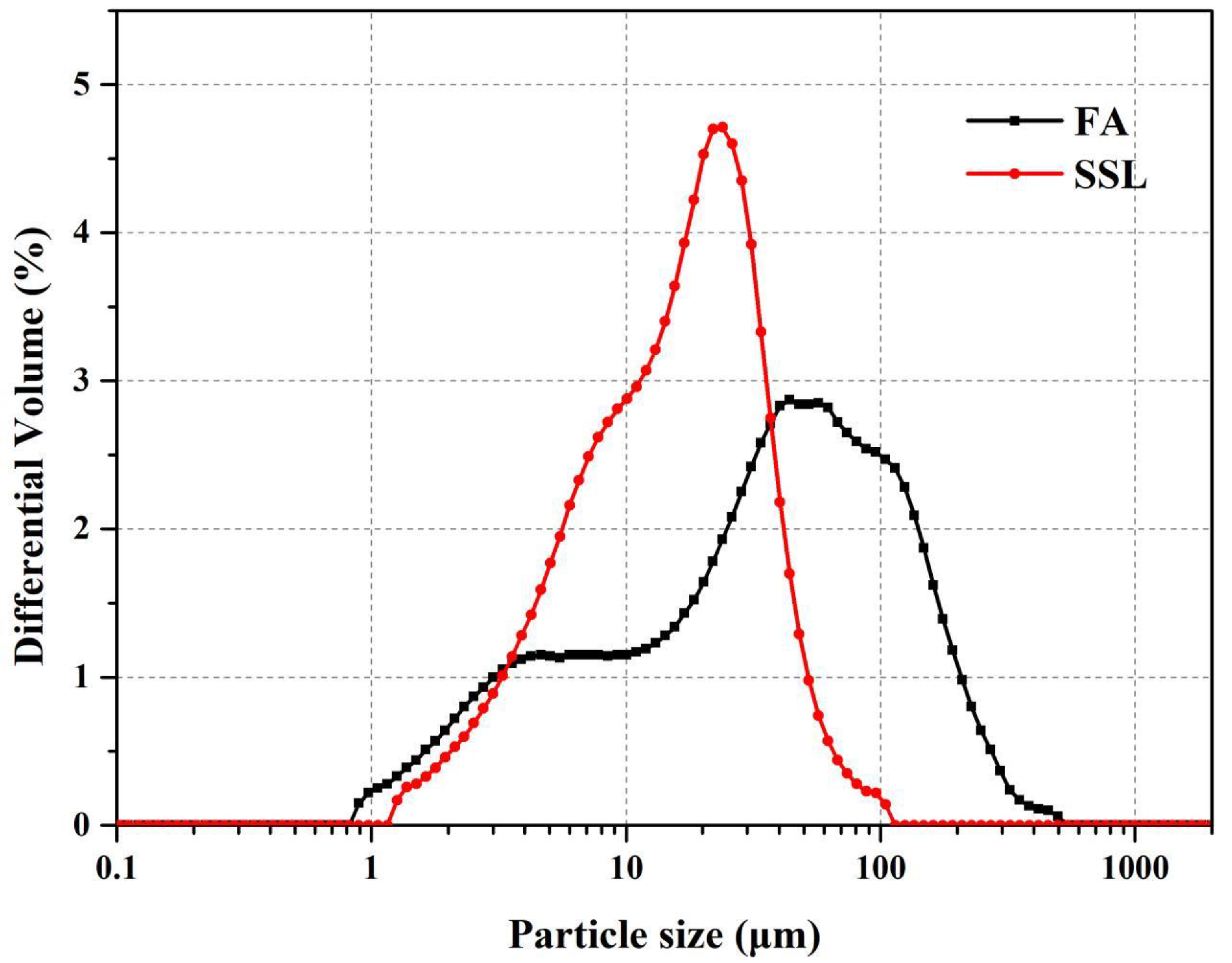
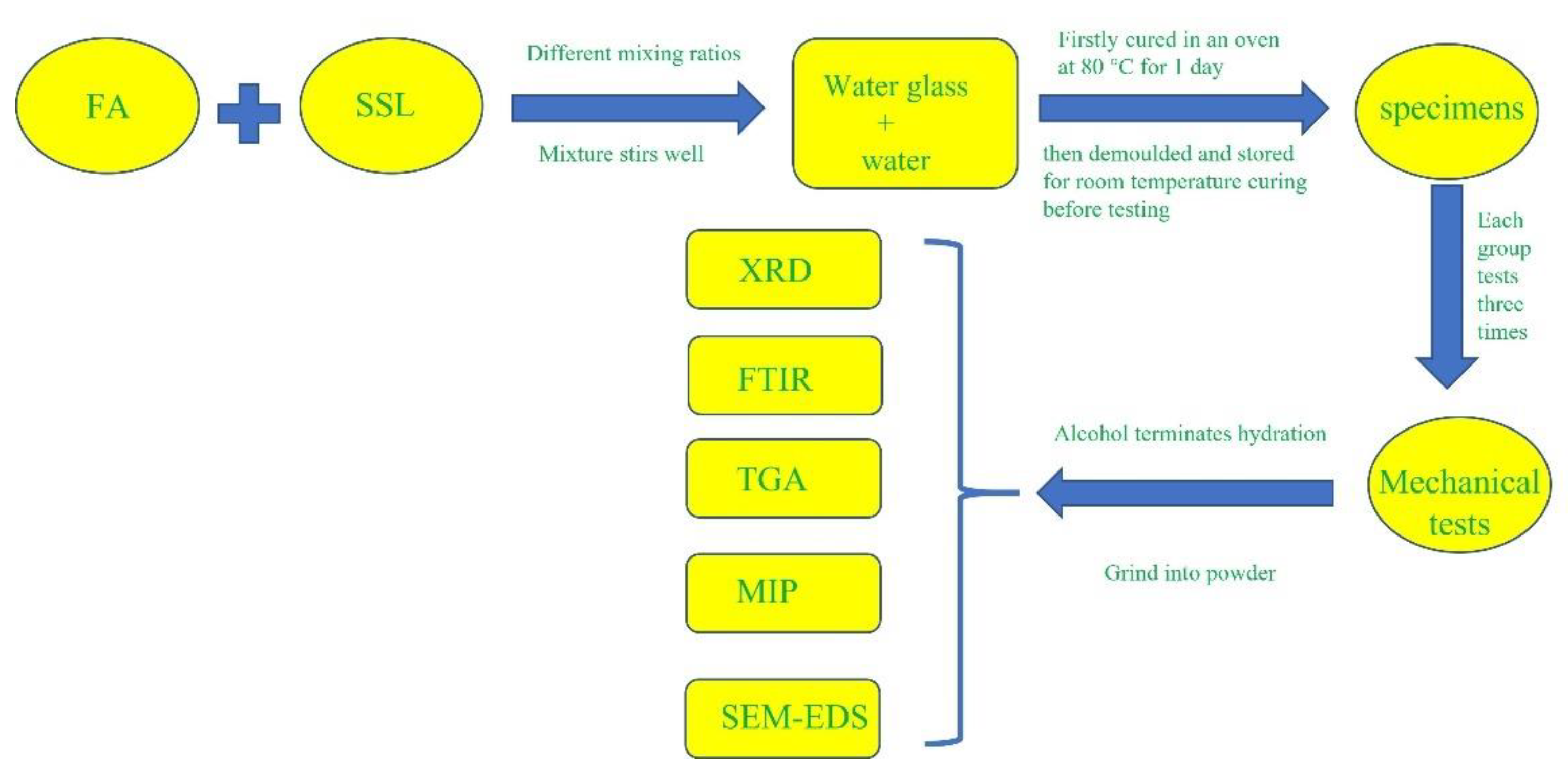

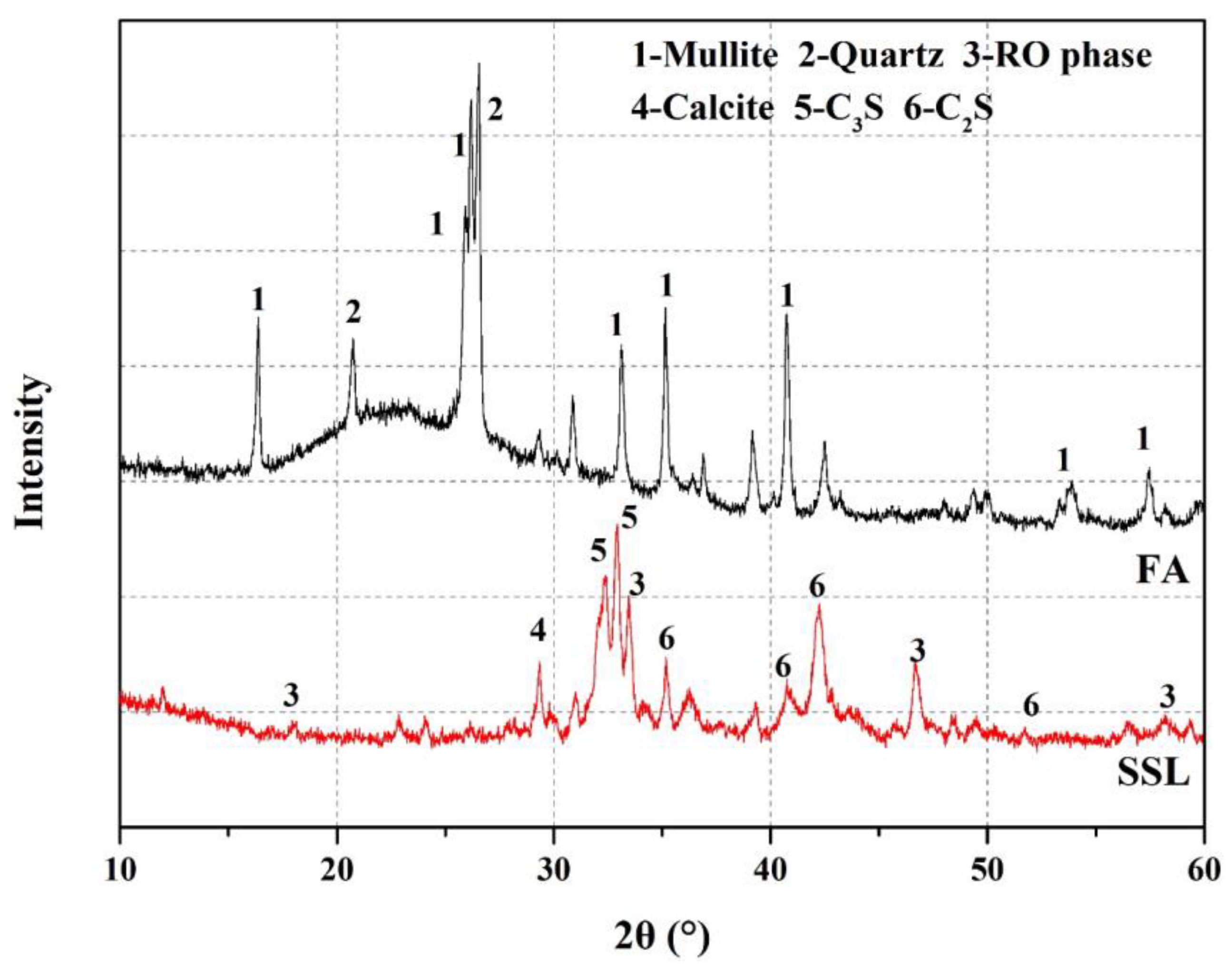
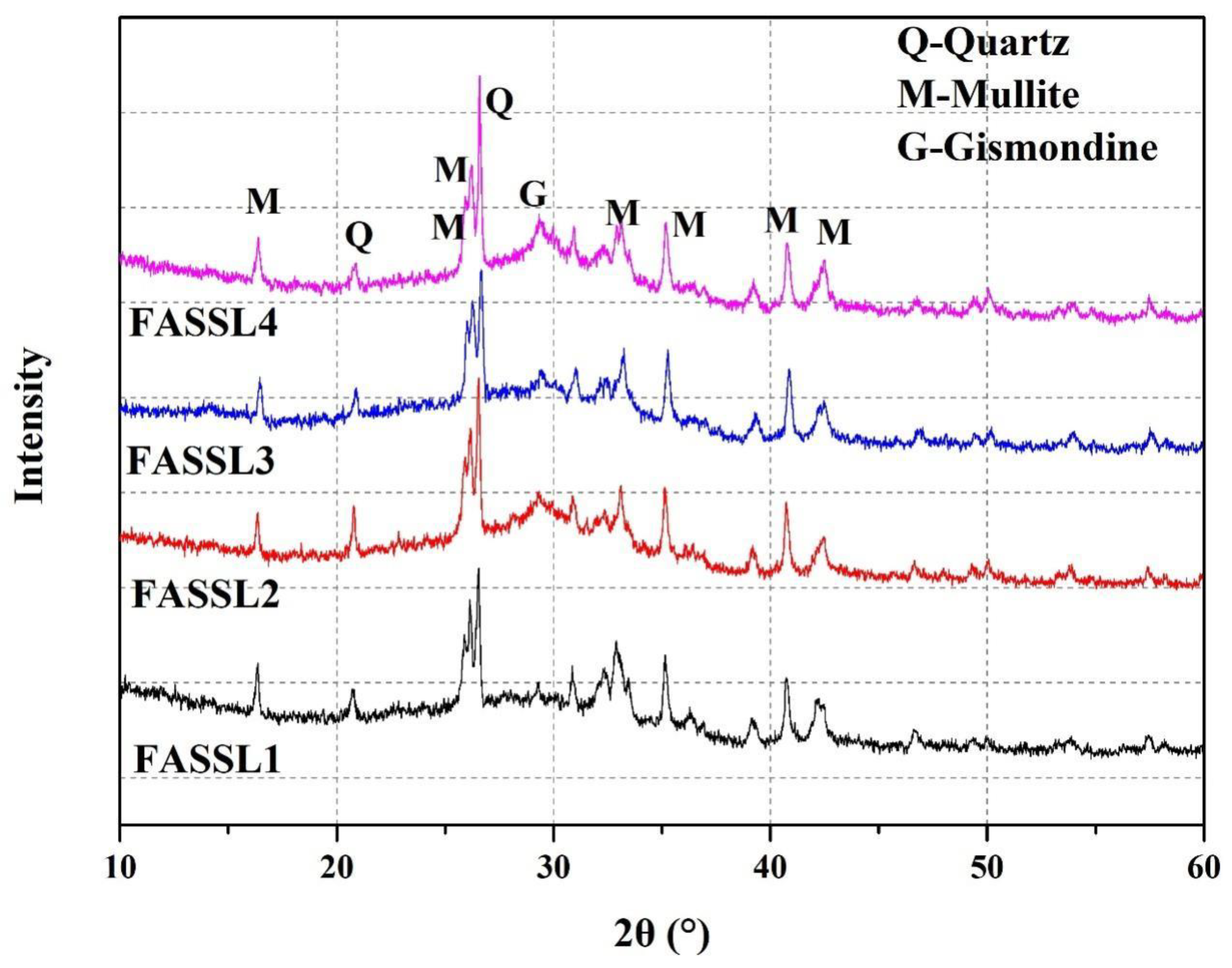

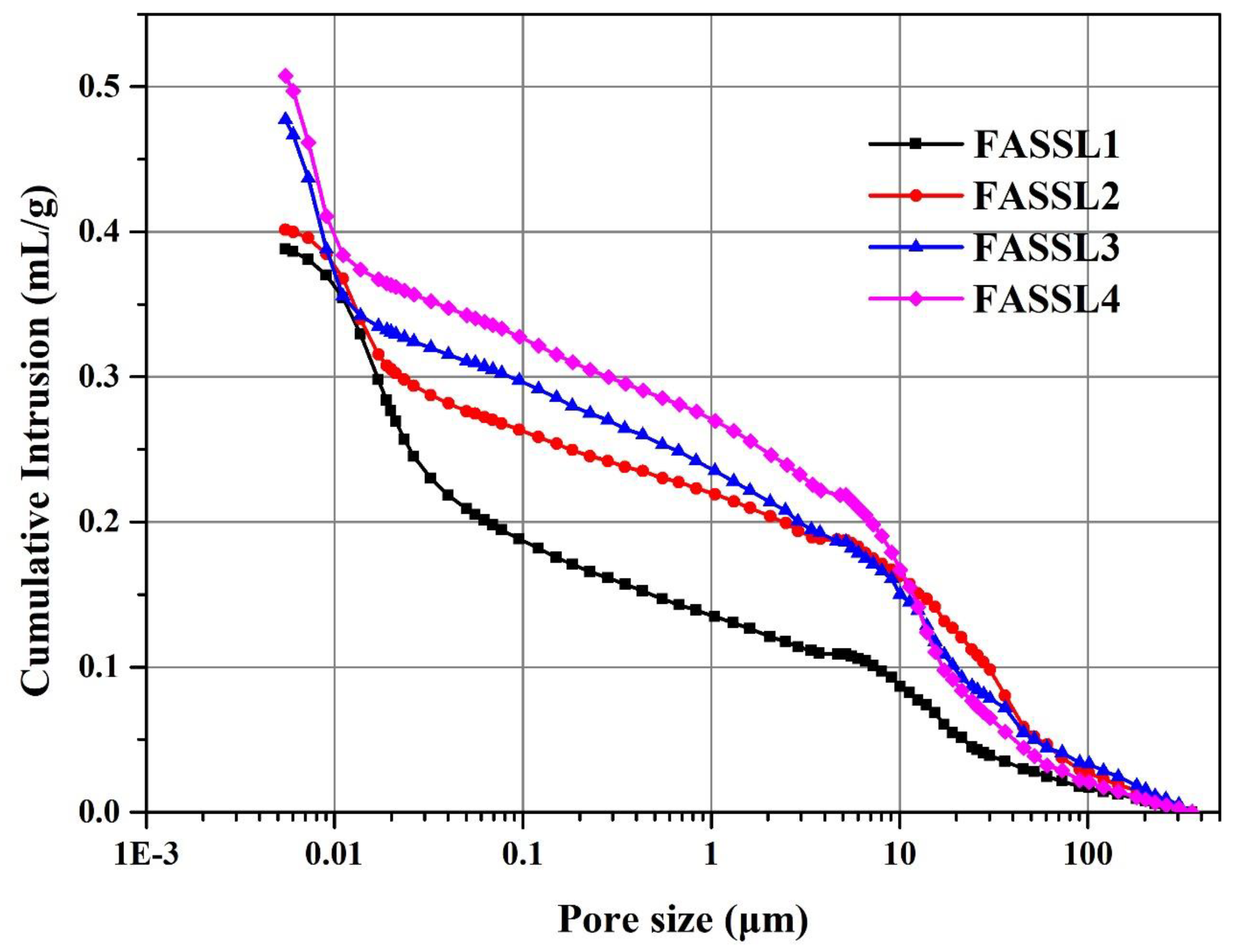
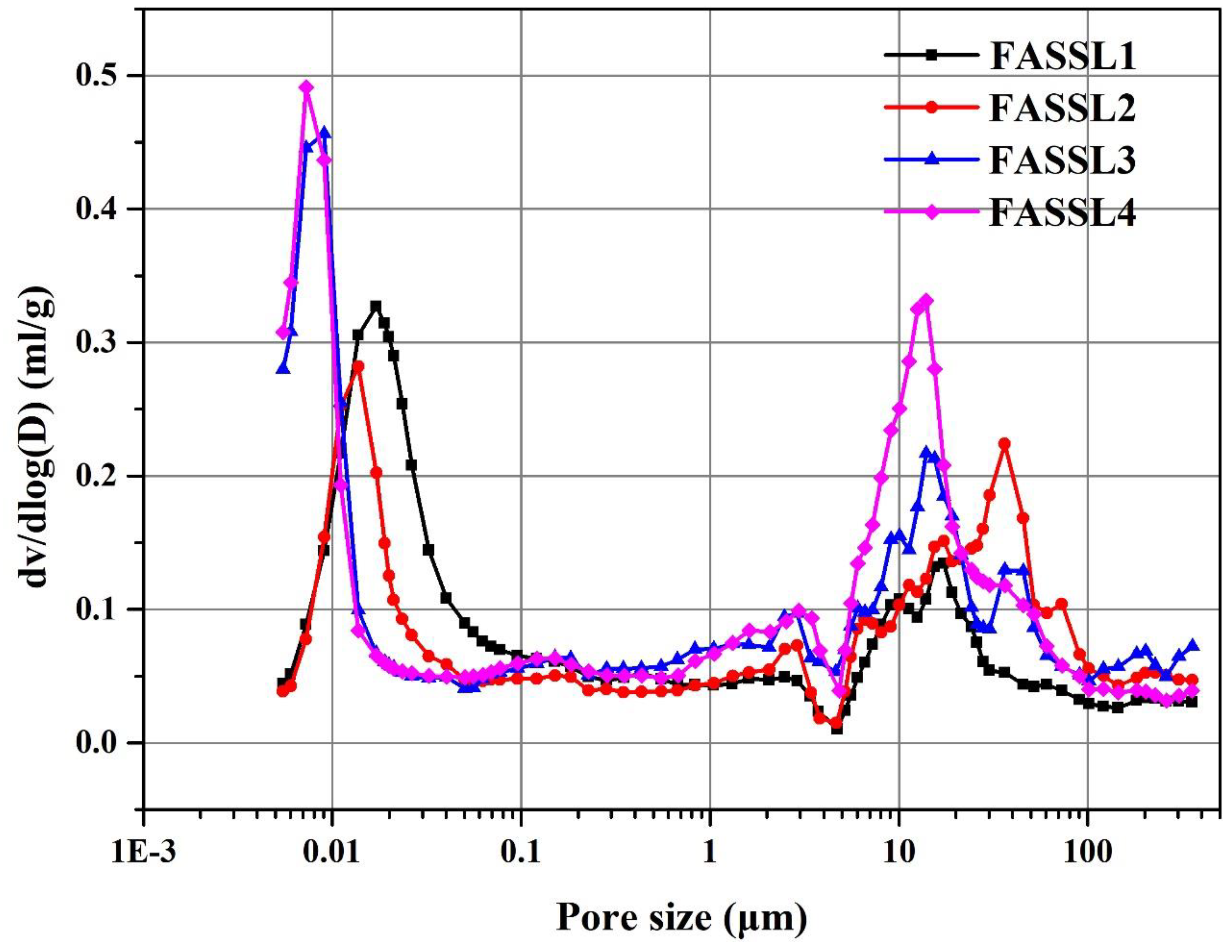



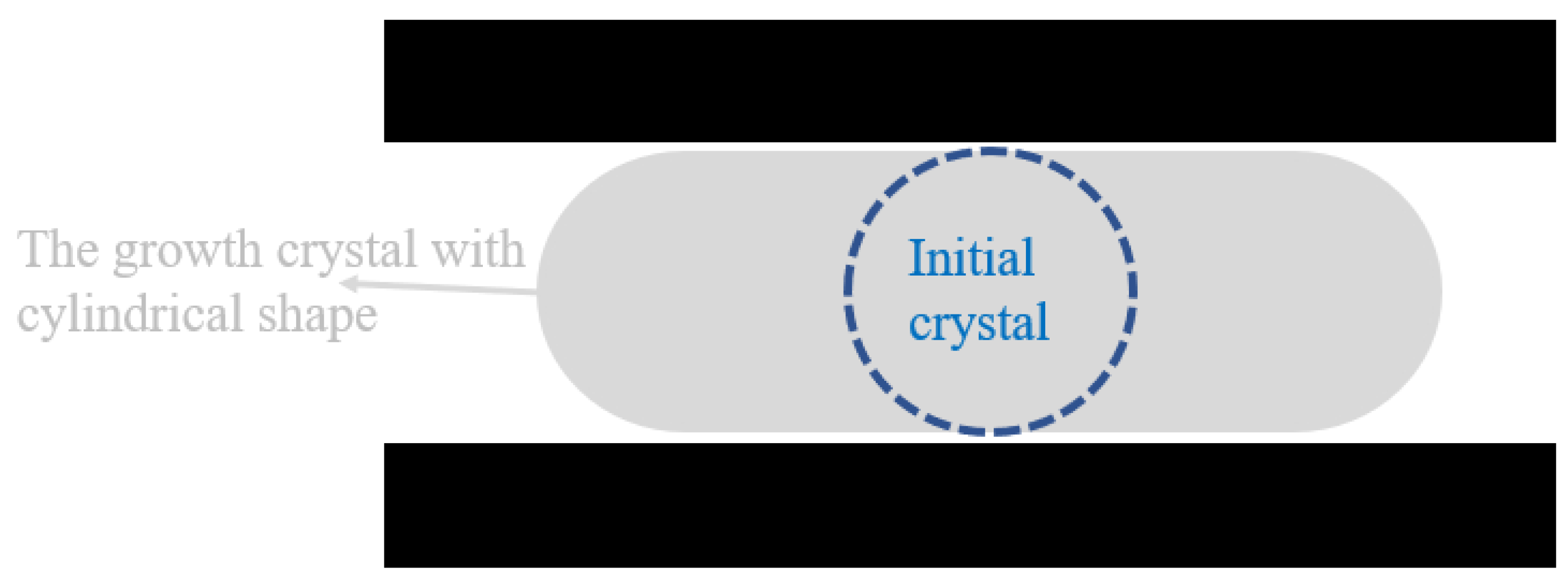
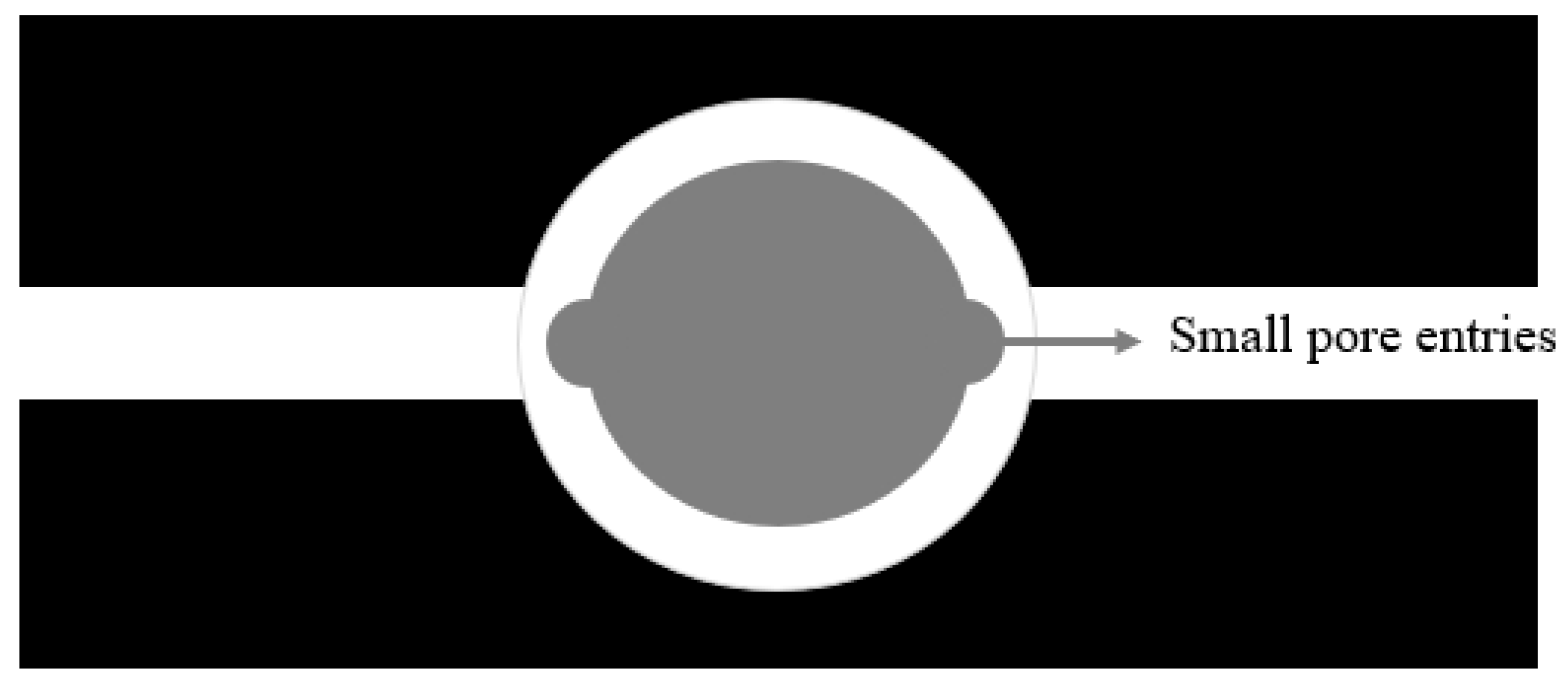
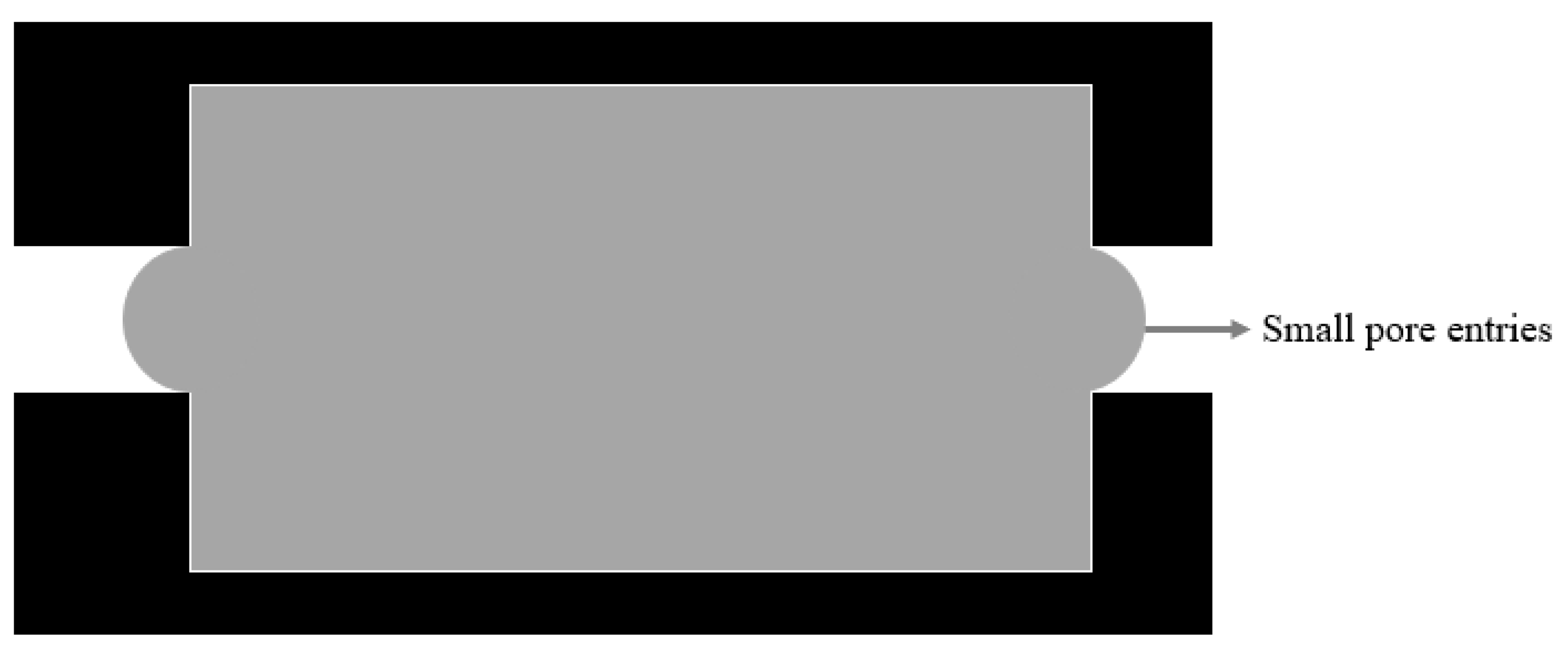
| Oxides (%) | SiO2 | CaO | MgO | Fe2O3 | Al2O3 | SO3 | Na2O | K2O | TiO2 | LOI |
|---|---|---|---|---|---|---|---|---|---|---|
| FA | 46.36 | 9.17 | 5.41 | 3.27 | 27.13 | 0.39 | 0.47 | 0.73 | - | 7.07 |
| SSL | 20.94 | 39.88 | 6.63 | 20.74 | 6.13 | 0.04 | - | - | - | 5.64 |
| Specimen | FA (g) | SSL (g) | Alkaline Activator (g) | Water-Binder |
|---|---|---|---|---|
| FASSL1 | 260 | 140 | 240 | 50.78% |
| FASSL2 | 240 | 160 | 240 | 50.78% |
| FASSL3 | 220 | 180 | 240 | 50.78% |
| FASSL4 | 200 | 200 | 240 | 50.78% |
| Sample | Porosity (%) |
|---|---|
| FASSL1 | 45.16 |
| FASSL2 | 49.63 |
| FASSL3 | 52.85 |
| FASSL4 | 57.49 |
Disclaimer/Publisher’s Note: The statements, opinions and data contained in all publications are solely those of the individual author(s) and contributor(s) and not of MDPI and/or the editor(s). MDPI and/or the editor(s) disclaim responsibility for any injury to people or property resulting from any ideas, methods, instructions or products referred to in the content. |
© 2024 by the authors. Licensee MDPI, Basel, Switzerland. This article is an open access article distributed under the terms and conditions of the Creative Commons Attribution (CC BY) license (https://creativecommons.org/licenses/by/4.0/).
Share and Cite
Zang, J.; Yao, C.; Ma, B.; Shao, Z.; Zhang, H.; Wang, J.; Qian, B.; Zhou, H.; Hu, Y. The Performance and Reaction Mechanism of Untreated Steel Slag Used as a Microexpanding Agent in Fly Ash-Based Geopolymers. Buildings 2024, 14, 463. https://doi.org/10.3390/buildings14020463
Zang J, Yao C, Ma B, Shao Z, Zhang H, Wang J, Qian B, Zhou H, Hu Y. The Performance and Reaction Mechanism of Untreated Steel Slag Used as a Microexpanding Agent in Fly Ash-Based Geopolymers. Buildings. 2024; 14(2):463. https://doi.org/10.3390/buildings14020463
Chicago/Turabian StyleZang, Jun, Chunlei Yao, Bing Ma, Zhiyuan Shao, Houhu Zhang, Jiaqing Wang, Binbin Qian, Hao Zhou, and Yueyang Hu. 2024. "The Performance and Reaction Mechanism of Untreated Steel Slag Used as a Microexpanding Agent in Fly Ash-Based Geopolymers" Buildings 14, no. 2: 463. https://doi.org/10.3390/buildings14020463
APA StyleZang, J., Yao, C., Ma, B., Shao, Z., Zhang, H., Wang, J., Qian, B., Zhou, H., & Hu, Y. (2024). The Performance and Reaction Mechanism of Untreated Steel Slag Used as a Microexpanding Agent in Fly Ash-Based Geopolymers. Buildings, 14(2), 463. https://doi.org/10.3390/buildings14020463






